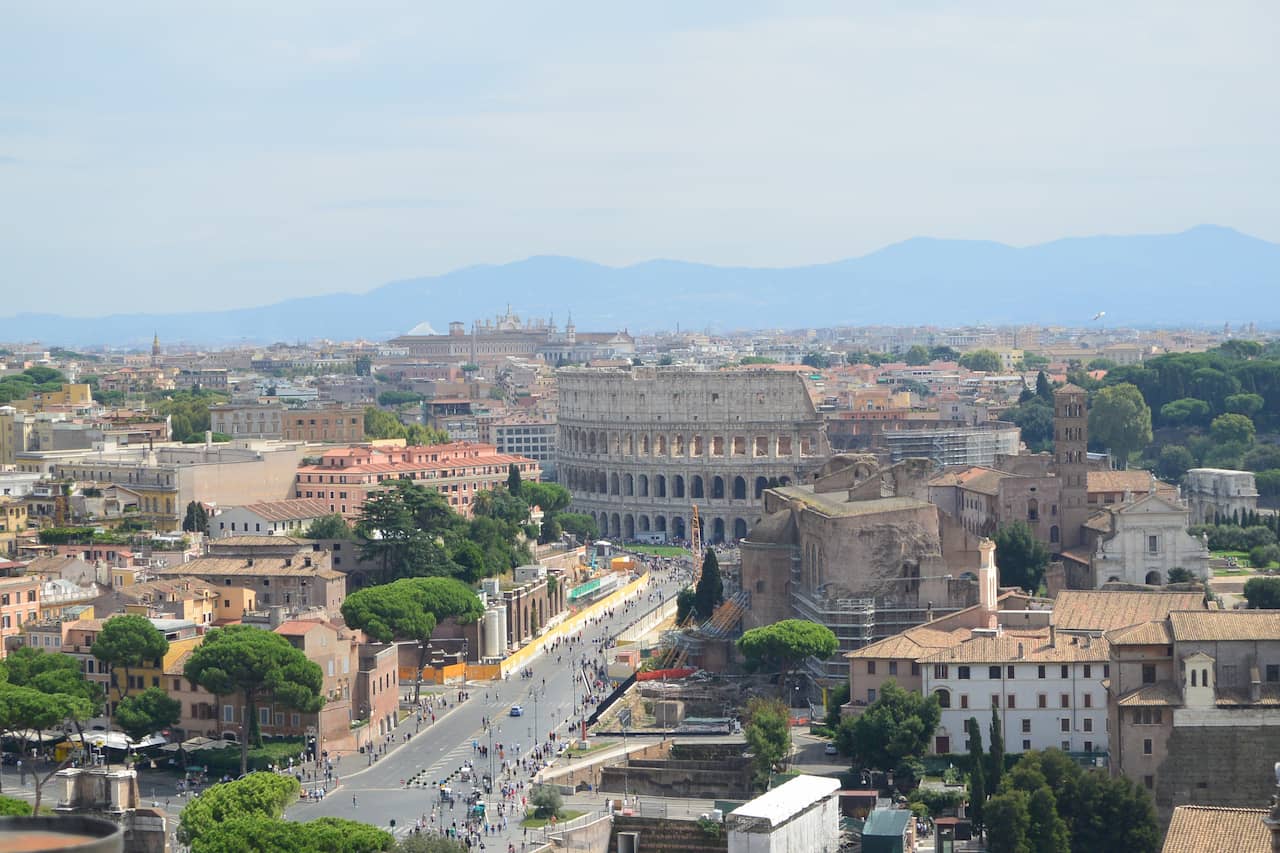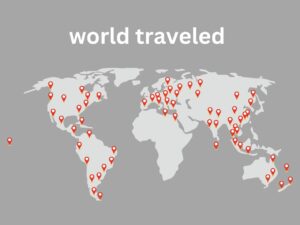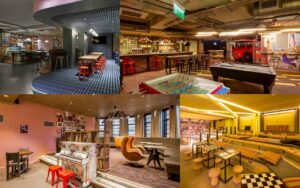Traveling to Rome is on most people’s minds, especially from the Americas and Brazil.
Brazil is one of the most Catholic people in the world
Rome, the capital of Italy, considered the center of the Western world for centuries.
Cradle of Western civilization and epicenter of the ancient Roman Empire, its imposing monuments and fascinating ruins tell the story of a glorious past.
Rome is the birthplace of Caesar and the seat of the Catholic Church. Here you walk down the street and see modern buildings next to ruins that date back thousands of years.
A little history of Rome:
Rome’s history is vast and complex, marked by an extraordinary rise from its humble beginnings to become the epicenter of a vast empire and later a cultural beacon for the Western world.
According to legend, Rome was founded by Romulus and Remus, twin brothers raised by a she-wolf, and its history dates back to the 8th century BC. Initially a small village, Rome grew in power and influence, eventually establishing itself as a republic in 509 BC. Republican period saw Rome expand through military conquests and institute a political system based on citizen participation.
Over time, Rome consolidated its dominance over the Italian Peninsula and expanded across Europe, North Africa and the Middle East. This period of expansion culminated in imperial rule, beginning with the reign of Augustus in 27 BC. Rome became a vast and powerful empire, known for its administrative ingenuity, legal system, and impressive infrastructure, including an extensive network of roads.
Rise of the Roman Empire.
At the height of its power, the Roman Empire encompassed vast territories and was a center of commerce, culture and innovation. However, internal and external challenges led to the gradual decline of the Empire, marked by political crises, military pressures, internal divisions and barbarian invasions.
The Western Roman Empire fell in 476 AD, while the Eastern Roman Empire, known as the Byzantine Empire, continued to exist for over a thousand years, with Constantinople (present-day Istanbul) as its capital.
Rome’s influence persisted through the legacy of its laws, language, architecture, and culture, which profoundly shaped Western civilization. Its impact is evident in modern aspects such as the legal system, the Latin language (which gave rise to several European languages) and architecture inspired by Roman buildings.
The story of Rome is a testament to the rise and fall of empires, as well as a narrative rich in conquests, political intrigue, cultural advances, and lasting legacies that shaped the world we live in today.
Main attractions
1. Take a free walking tour
In my opinion, the best way to discover a new destination is to go on walking tours.
Today major cities have free walking tours which are an economical way to see the main sights, learn about the destination, meet new people.
In Rome you have these options: the Rome Ultimate Free Walking Tour or the New Rome Free Tours. Their tours cover all the highlights and can introduce you to the city on a budget.
If you like it, leave a tip.
2. Admire the Trevi Fountain.
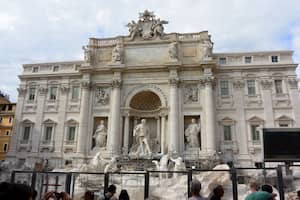
Trevi Fountain:
The 18th century Trevi Fountain was built at the end of the aqueduct that supplied water to ancient Rome.
One of the most famous fountains in the world, known for its sculptural beauty and the ritual of throwing a coin over one’s shoulder to ensure return to Rome.
3. Visit the Roman Forum.
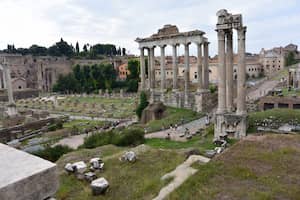
Roman Forums:
A series of public squares, temples, and government ruins that were the center of political, religious, and commercial life in Ancient Rome.
4. Colosseum in Rome.
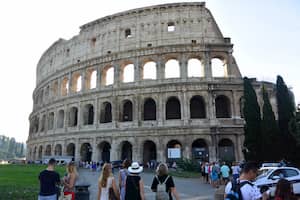
Coliseum:
This amphitheater is one of Rome’s most recognizable icons, built in the 1st century AD to host spectacular games and events, such as gladiator fights and animal competitions.
More information about the Coliseum here.
5. Visit the Vatican, St. Peter's Basilica and the Sistine Chapel.
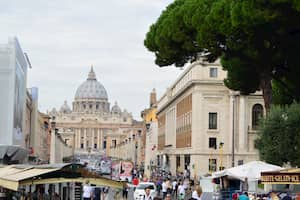 Vatican and St. Peter’s Basilica:
Vatican and St. Peter’s Basilica:
The smallest independent state in the world, the Vatican is home to St. Peter’s Basilica, one of the largest Christian temples, and the Vatican Museums, which include the famous Sistine Chapel, decorated by Michelangelo.
6. Spanish Steps.
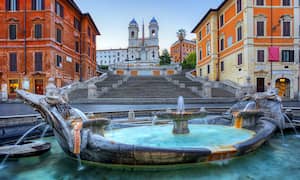
Spanish Steps:
One of the most famous squares in Rome, characterized by the elegant stairs that lead to the Trinità dei Monti church, offering a stunning view of the city.
7. Go to Piazza Navona.
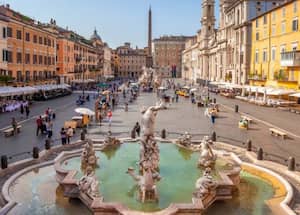 Piazza Navona:
Piazza Navona:
One of Rome’s liveliest squares, known for its spectacular fountains, street art and charming cafes
It is home to Bernini’s Fontana dei Quattro Fiumi, with its impressive statues representing the world’s great rivers.
8. Galleria Borghese.
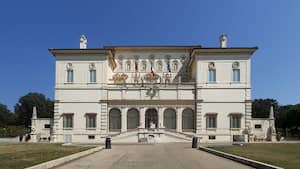
Borghese Gallery:
A museum with an impressive collection of sculptures, paintings and artefacts, including works by Bernini, Caravaggio and Raphael.
9. Don't miss seeing the Pantheon.
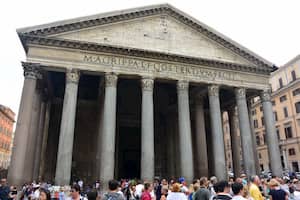
Pantheon
One of the best-preserved monuments of Ancient Rome, the Pantheon is famous for its impressive dome and is considered an example of extraordinary Roman architecture.
10. Visit the Castle of Sant’Angelo.
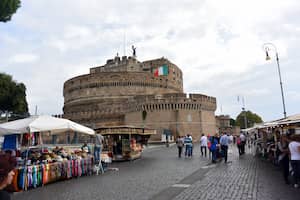
Castel Sant’Angelo, ‘The Castle of Angels’, is an attractive cylindrical fortification built on the banks of the River Tiber by the Roman Emperor Hadrian in the 2nd century AD.
Today, it is a museum with frescoed rooms, a collection of medieval weapons and stunning views of the city of Rome and nearby St. Peter’s Basilica.
11. Walk to Gianicolo.
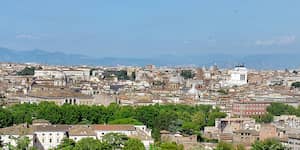 Located above the Trastevere neighborhood, Gianicolo isn’t technically one of the legendary hills, but it’s worth the hike because it’s the highest point in Rome and offers expansive views over the Eternal City.
Located above the Trastevere neighborhood, Gianicolo isn’t technically one of the legendary hills, but it’s worth the hike because it’s the highest point in Rome and offers expansive views over the Eternal City.
12 Explore the Testaccio neighborhood.
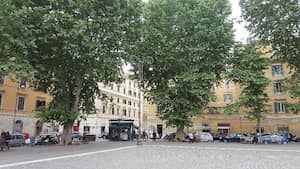
Testaccio neighborhood.
Rome’s culinary traditions are rooted in the Testaccio neighborhood, making it a must-see for gourmets and intrepid diners. One of the best places to sample Rome’s diverse cuisine and excellent street food is at the Testaccio Market.
13 Olympic Stadium for football lovers.
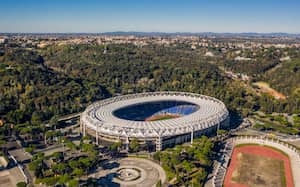
Olympic Stadium.
Rome has two first-class football clubs, A Roma and SS Lazio, both play at the Olympic Stadium, actually the largest sports complex in Rome.
14 Church of São Luís dos Franceses.
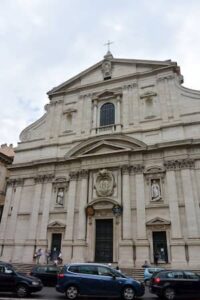
Church of São Luís dos Franceses.
If you are a fan of Caravaggio, you will want to visit the Church of Saint Louis of the French. Inside this church near Piazza Navona are three works by the Baroque artist, including “The Calling of Saint Matthew”, “Saint Matthew and the Angel” and “The Martyrdom of Saint Matthew”.
15 Visit the Trastevere neighborhood.
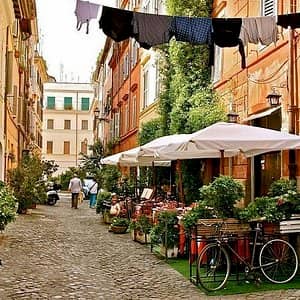
Trastevere
To get to know the real Rome it is good to visit Trastevere, located southeast of Vatican City, this neighborhood is home to the Basilica of Santa Maria in Trastevere, as well as several restaurants and neighborhood shops.
It is compared to New York’s Greenwich Village.
Best time to visit Rome.
The best time to visit Rome depends on your choice and personal preferences regarding the climate, activities and desired level of tourist movement. Each station offers a unique experience in the city.
Winter (December to February):
Winters in Rome are mild compared to many other European cities to the north, but can still be cold and wet. Temperatures can range from cool to cold. However, this is an excellent time to visit if you prefer to avoid crowds. Additionally, Christmas markets and festive decorations create an enchanting atmosphere, especially during the end-of-year festivities.
Spring (March to May):
This is often considered one of the best times to visit Rome. Temperatures are pleasant, generally varying from mild to hot. The gardens and parks are in bloom, and you can enjoy sunny days ideal for exploring the ancient ruins and monuments without the intense summer heat. The crowds aren’t at their peak yet, so it’s a good time to visit the most popular tourist spots.
Summer (June to August):
Summer in Rome can be quite hot and busy. Temperatures often exceed 30°C, and the city can be crowded with tourists. However, the days are long and there are a multitude of outdoor events, festivals and cultural activities happening during this time. It’s great for enjoying the fountains, squares and vibrant nightlife.
Autumn (September to November):
Autumn brings mild temperatures and shorter days, but still quite pleasant for exploring the city.
Crowds thin out a bit after summer, making it easier to visit the main tourist spots. The leaves on the trees begin to change color, creating an enchanting landscape.
How to get to Rome.
Getting to Rome is relatively easy, as the city is an important transport hub in Italy. In Brazil there are some direct flights and many with stopovers.
Main means of transport;
Plane:
Leonardo da Vinci Airport, also known as Fiumicino Airport (FCO), is Rome’s main international airport. It receives flights from all over the world. There is also Ciampino Airport (CIA), which mainly serves low-cost airline and charter flights. From the airport, you can take taxis, buses or trains to the city center.
Train:
Rome has excellent rail connections. The main station is Roma Termini Station, which receives trains from several Italian cities and other European countries. Italo and Trenitalia are the main train operators in Italy.
Bus:
There are bus services that connect Rome with several Italian and European cities. The main bus companies include FlixBus, Eurolines and Megabus.
Car:
If you are traveling within Italy or neighboring countries, it is possible to reach Rome by car. However, traffic in the city can be heavy, and parking can be challenging, especially in the historic center.
Getting around Rome.
For me, the best ways to get around are always on foot and public transport.
That’s why I always stay close to attractions and/or public transportation.
Rome is a very large city, traffic is very slow, but the public transport system is very efficient.
On foot
On foot it is possible to admire the life of the city’s population while seeing its main attractions.
Many of the city’s main tourist attractions are about 2 KM away. When you need to go further afield, there is a very efficient metro and bus network.
Car
It is not advisable to visit the city by car, as in addition to the traffic, parking is very expensive and difficult.
If you have a car, it is best to park it outside the center and travel on foot and using public transport.
Public transportation
The best way to get around Rome is on foot and by metro to make it easier to see the closest stations to each attraction
Line A
Cipro or Ottaviano – Visit the Vatican Museum, St. Peter’s Basilica and the Sistine Chapel.
Spagna – Very practical for visiting Piazza di Spagna and Villa Borghese.
Barberini – 5 minutes from the Trevi Fountain and closest to Piazza Navona and the Pantheon.
Termini – Station where the two lines run and the arrival point of the Leonardo Express from Fiumicino airport.
Line B
Termini – the station where the two lines run and the arrival point for the Leonardo Express at Fiumicino airport.
Colosseum – Located next to the Colosseum and the Roman Forum.
Circus maximo – Close to the circus maximo and Coliseum among other attractions
What is the best neighborhood to stay in Rome?
Rome is an expensive city and being in the best place can, in addition to reducing the cost, make your visit easier.
Below is a summary of the best neighborhoods to stay.
Pantheon / Piazza Navona / Campo de Fiori – Ideal for first-time visitors. Easily walk to the city’s main sights and enjoy the atmosphere of one of the world’s greatest cities
Piazza di Spagna – home to luxury hotels and sophisticated shops. Being close to the Villa Borghese gardens means this area of Rome is also great for families
Trastevere – Charming neighborhood close to the historic center, known for small cobblestone streets and a thriving food scene
Coliseum / Monti – an interesting combination of ancient sites and bohemian neighborhood. It’s not so easy to walk to other places from here
Vatican / Prati – elegant residential area that is a useful base for St. Peter’s Square and the Vatican Museums
Roma Termini – best area in Rome for budget travelers and those who need quick transit outside of Rome
Testaccio – interesting neighborhood with great restaurants and bars, as well as specialty stores.
Where to stay.
Over time, the way we travel and stay changes.
I’ve been to 5-star hotels and hostels with shared rooms for up to 10 people.
Today I have been looking for a new way to stay that is a mix of Airbnb and hotels.
They are “apartments”, small or not with the infrastructure to cook, so in addition to having better privacy, they save on the cost of meals and I am not paying for infrastructure that I do not use, such as a swimming pool, gym, etc.
They are classified between economic and medium, but with very significant savings on food.
I explain better here.
Economic :
Just 200 meters from Roma Termini Train Station, Palladini Hostel Rome offers air-conditioned dormitories with free Wi-Fi.
Average:
Casa Valentina offers accommodation with a terrace, free WiFi, a 24-hour front desk and an elevator.
LUX:
Centrally located in Rome, Tree Charme is set on the banks of the River Tiber, opposite Piazza Trilussa. It offers free Wi-Fi throughout, a terrace and elegant rooms.
Gastronomy in Rome.
Rome’s cuisine is diverse and offers a variety of delicious dishes.
Some of the Main Dishes.

Cacio e Pepe:
A simple but divine pasta made with pecorino Romano cheese, black pepper and spaghetti. The simplicity of the ingredients highlights the flavor and quality of the cheese.

Pizza in Rome is different from Neapolitan pizza. It has a thinner and crispier dough, traditionally made with white flour, water, yeast, salt and olive oil.
The main pizza in Rome is “Pizza al Taglio”. This is prepared in rectangular trays, often sold by weight.

Carbonara:
Another pasta dish, made with spaghetti, pecorino Romano cheese, egg, guanciale (a type of bacon made from pork cheek) and black pepper. It’s creamy, salty and absolutely delicious.
 Supplì:
Supplì:
A Roman appetizer or snack, similar to a croquette, made with cooked rice, tomato sauce, mozzarella, and sometimes a little meat. It is breaded and fried, resulting in a creamy and flavorful center
 Abbacchio alla Romana: Roast lamb, often served with potatoes, garlic, rosemary and white wine. It is a typical delicacy of the Lazio region, where Rome is located.
Abbacchio alla Romana: Roast lamb, often served with potatoes, garlic, rosemary and white wine. It is a typical delicacy of the Lazio region, where Rome is located.
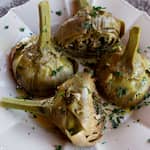
Carciofi alla Romana: Artichokes prepared with herbs, olive oil and garlic, cooked until soft and tasty. It is a seasonal specialty, usually found in spring.
Tipical drinks:
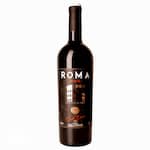 Italy is known for its wine production, and Rome is no exception. You will find a wide selection of Italian wines, both local and from other regions of the country. Try white wines like Frascati or Orvieto, or reds like Chianti, Montepulciano or Brunello di Montalcino.
Italy is known for its wine production, and Rome is no exception. You will find a wide selection of Italian wines, both local and from other regions of the country. Try white wines like Frascati or Orvieto, or reds like Chianti, Montepulciano or Brunello di Montalcino.
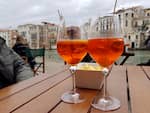 Spritz:
Spritz:
A very popular aperitif drink in Italy, made with Prosecco, sparkling water and a variety of liqueurs such as Aperol, Campari or Select. It is served with ice and a slice of orange or olive.
 Birra: Italian beer is also popular, and in Rome you will find a variety of local and international beers in bars and restaurants.
Birra: Italian beer is also popular, and in Rome you will find a variety of local and international beers in bars and restaurants.
 Coffee: Italians are famous for their coffee, and in Rome you’ll find a wide variety of styles, from espresso to cappuccino and macchiato. Enjoy a cup of coffee in one of the city’s historic cafes.
Coffee: Italians are famous for their coffee, and in Rome you’ll find a wide variety of styles, from espresso to cappuccino and macchiato. Enjoy a cup of coffee in one of the city’s historic cafes.
3 day itinerary in Rome
In my experience, any city can be well visited in two full days.
Depending on the type of visit you want to make.
However, Rome is one of the exceptions, it needs at least 3 days
First day.
I recommend starting at the Trevi Fountain, as the earlier there are fewer people and the better photos you can take.
The closest metro is Barberini, about 600 meters from Fonte.
Going straight, you pass the Church of Saint Ignatius of Loyola and in another 10 minutes you reach the Pantheon.
Another 10 minutes walk and you reach Navona Square, one of the most famous in the historic center.
It is worth exploring the surroundings and heading towards the Tiber River and the Vittorio Emanuele II bridge.
After crossing the bridge on the right is the castle of Santo Angelo.
The main road giving access to the Vatican is “Via della Conciliazione”. This wide and imposing avenue connects the Castel Sant’Angelo area directly to St. Peter’s Square, providing a spectacular view of St. Peter’s Basilica.
Explore St. Peter’s Square and Basilica.
Now it’s time to relax, have dinner and rest for the next day
Second day
It’s best to arrive at the Coliseum early, as the queues are shorter.
Once you enter, you can enter the Roman Forum, which is just across the street, allowing you to relax and enjoy the history and architecture of the Coliseum.
To get a clear and detailed view of the Forum it takes about 2 to 3 hours.
Right at the exit we find the campidoglio designed by Michelangelo.
A few minutes away we have the imposing Altar of the Fatherland where the monument to Vittorio Emanuele II stands. By paying a ticket, you can access the panoramic terrace with beautiful views of Rome.
Here is a good place to have lunch and rest a little, but if you can wait another 30 minutes, a great option is to have lunch in the Trastevere neighborhood, which is heading towards the Tiber River, crossing the Garibaldi bridge.
The neighborhood is one of the most picturesque and charming in the city.
Like its narrow cobblestone streets, charming squares, medieval architecture and Bohemian atmosphere.
Great place to end today’s tour.
Third day
A good part of the day will be dedicated to visiting the Vatican Museum and seeing the Sistine Chapel.
Arriving early is important because of the queues, or buying timed tickets makes it easier.
At least 3 to 4 hours are needed for this visit.
At the exit there are many restaurants, but for a better cost and more options to go to the Villa Borguese region.
It can be about 40 minutes on foot or take the metro and get off at Barberini station.
Visit the Spanish stairs in Piazza Spagna.
Explore the region, but head towards Villa Borghese, which is a vast urban park with landscaped gardens, a lake and important museums.
A great place to rest, enjoy nature and end the day.
How much does it cost?
3 styles and their costs
Backpacker:
Stayed in hostels using shared dormitories, eating your own food and/or cheap local restaurants, using local transport, exploring the city on foot and taking tours for free or cheaper.
Daily expenditure: from US$ 60.00 to 80.00 per day
Intermediary:
Stay in hostels/budget hotels in private rooms, eat in a medium-sized restaurant, go to the main paid attractions, use some taxis and Uber.
Daily spending: US$100.00 to 200.00 USD per day.
Luxurious:
Stayed in the best hotels, go to all the attractions, hire more sophisticated packages such as use of a helicopter, etc.
Daily spend: US$250.00 and above per day
